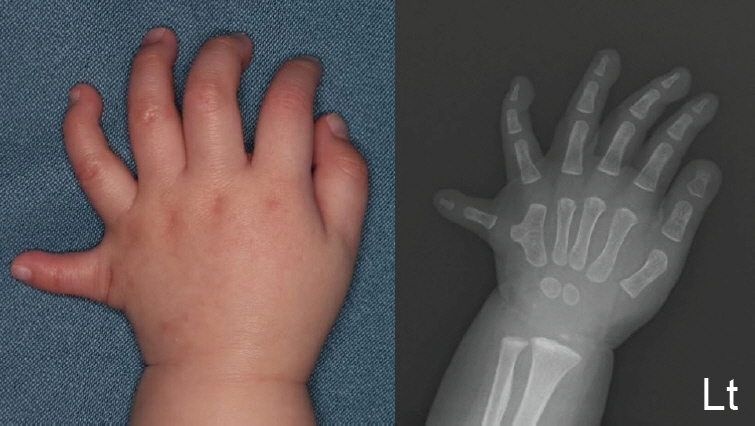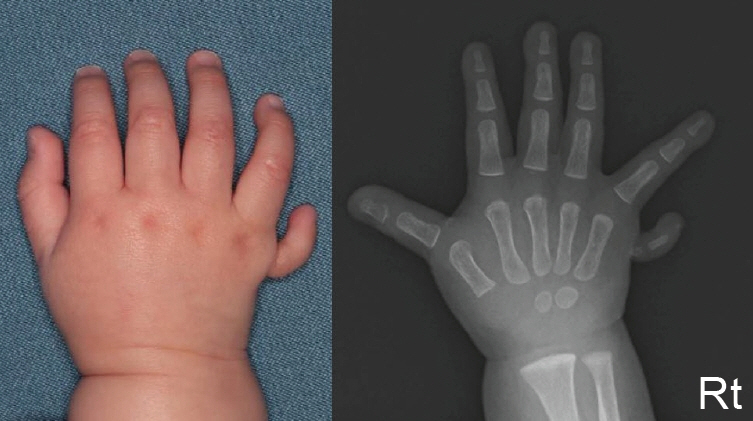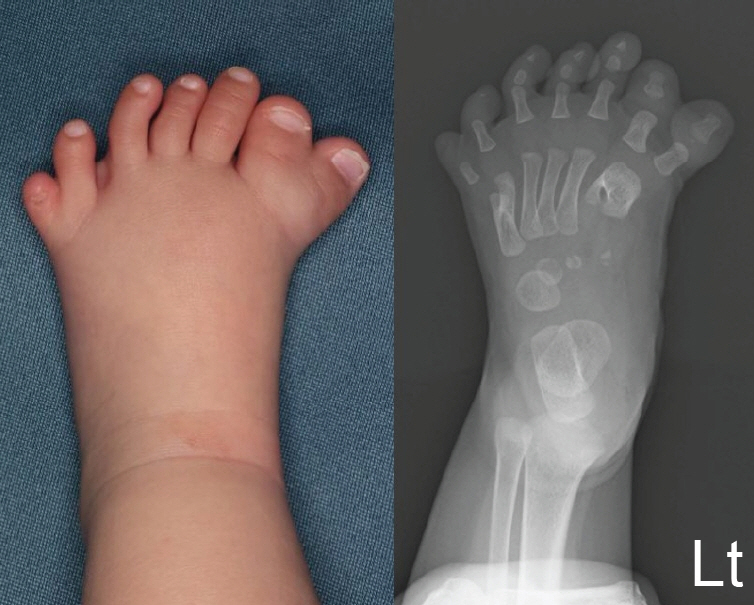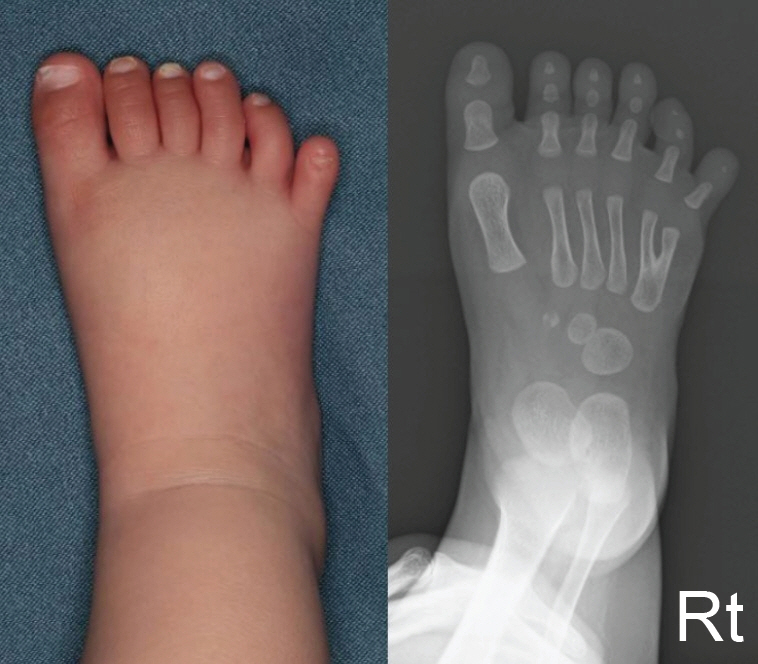Arch Hand Microsurg.
2024 Sep;29(3):187-190. 10.12790/ahm.24.0025.
Tetrapolydactyly: a rare presentation and review of the literature
- Affiliations
-
- 1Department of Plastic and Reconstructive Surgery, Faculty of Medicine and Graduate School of Medicine, Hokkaido University, Sapporo, Japan
- 2Department of Plastic and Reconstructive Surgery, Sapporo City General Hospital, Sapporo, Japan
- KMID: 2558743
- DOI: http://doi.org/10.12790/ahm.24.0025
Abstract
- Polydactyly is a common congenital anomaly characterized by the presence of extra digits on the hands and/or feet, potentially involving all four limbs simultaneously. The terminology used to describe polydactyly involving all four limbs varies in the literature, with terms such as “tetrapolydactyly,” “polydactyly 24,” and “hexadactyly of all limbs” being used interchangeably. We encountered a case of tetrapolydactyly in a female neonate with postaxial polydactyly involving all four limbs. Our patient had an extra digit on the ulnar side with a bony component on the left hand and a similar extra digit without a bony articulation at the base of the right hand. The right foot showed postaxial polydactyly, and the left foot exhibited both preaxial polysyndactyly and postaxial polydactyly. A review of the literature shows that this combination of anomalies is extremely rare. A family history is present in approximately 30% of cases, asymmetric patterns are rarer than symmetric patterns, and heptadactyly is particularly uncommon. This report summarizes the information on tetrapolydactyly in the literature and discusses the clinical implications as well as management strategies.
Figure
Reference
-
References
1. Miura T, Nakamura R, Imamura T. Polydactyly of the hands and feet. J Hand Surg Am. 1987; 12:474–6.
Article2. Atanda OO, Owonikoko KM, Adeyemi AS, Bajowa O. Polydactyly 24 in a female neonate. Case Rep Obstet Gynecol. 2013; 2013:798138.3. Victor E, Victor A. Familial post-axial polydactyly of all limbs in a neonate. Int J Innov Res Med Sci. 2023; 8:40–3.
Article4. Sener RN. Case report 636: tetrapolysyndactyly with postaxial type of polydactyly. Skeletal Radiol. 1990; 19:542–4.5. Sener RN. Tetrapolydactyly of postaxial type. Pediatr Radiol. 1995; 25 Suppl 1:S234–5.
Article6. Hosalkar HS, Shah H, Gujar P, Kulkarni AD. Crossed polydactyly. J Postgrad Med. 1999; 45:90–2.7. Villa MC, Rocca A, Kantar A, Lovati C, Porcelli F. Hexadactylism of the four limbs: a case report. Pediatr Med Chir. 2006; 28:101–5.8. Radulescu A, David V, Puiu M. Polydactyly of the hand and foot case report. Jurnalul Pediatrului. 2006; 9:33–34.9. Mangalgiri AS, Sherke AR. Polydactyly 24: a case report. Int J Anat Var. 2009; 2:146–9.10. Wollina U, Verma SB. Sporadic familial ulnar hexadactyly of all four limbs. J Dermatol Case Rep. 2010; 4:6–10.
Article11. Mukherjee S, Paul R, Bandyopadhyay M, Das P. Post-axial polydactyly in four limbs with different bony configurations. Int J Anat Var. 2011; 4:77–9.12. Banerjee M, Majumdar SK. Hexadactyly in all four limbs in a neonate: a case report. J Dhaka Med Coll. 2013; 22:219–22.
Article13. Mohammed D, Haruna GI, Sadisu MM, Sule SA, Musa MA. Isolated tetrapolydactyly in a Nigerian girl. Int J Health Sci Res. 2017; 7:362–4.14. Rossi E, Barbieri A, Tamasi S, et al. Hexadactyly: a rare case. Biomed J Sci Tech Res. 2017; 1:1153–5.15. Rayan GM, Frey B. Ulnar polydactyly. Plast Reconstr Surg. 2001; 107:1449–57.
Article16. Belthur MV, Linton JL, Barnes DA. The spectrum of preaxial polydactyly of the foot. J Pediatr Orthop. 2011; 31:435–47.
Article17. Masada K, Tsuyuguchi Y, Kawabata H, Ono K. Treatment of preaxial polydactyly of the foot. Plast Reconstr Surg. 1987; 79:251–8.
Article18. Seok HH, Park JU, Kwon ST. New classification of polydactyly of the foot on the basis of syndactylism, axis deviation, and metatarsal extent of extra digit. Arch Plast Surg. 2013; 40:232–7.
Article
- Full Text Links
- Actions
-
Cited
- CITED
-
- Close
- Share
- Similar articles
-
- Caecal Duplication Cyst in an Infant: A Rare Presentation
- Traumatic Cervical Spondyloptosis of the Subaxial Cervical Spine: A Case Series with a Literature Review and a New Classification
- Primary Presentation of Malignant Lymphoma in the Middle Ear Cleft: A Case Report
- Extraperitoneal Spread of Anorectal Abscess: A Case Report and Literature Review
- Iatrogenic Hypervitaminosis A Complicated During Treatment of Rickets: Report A Case





